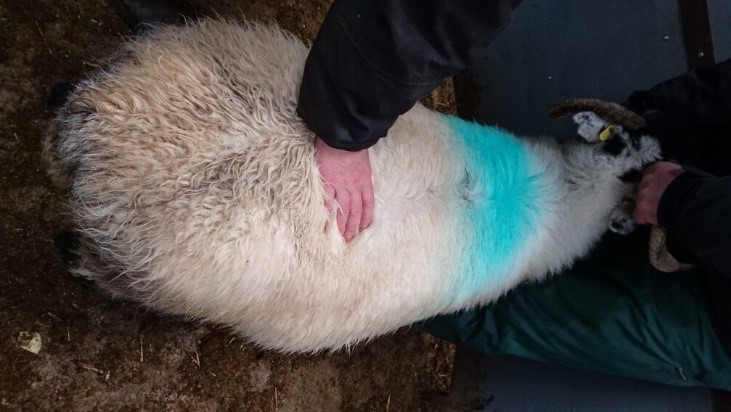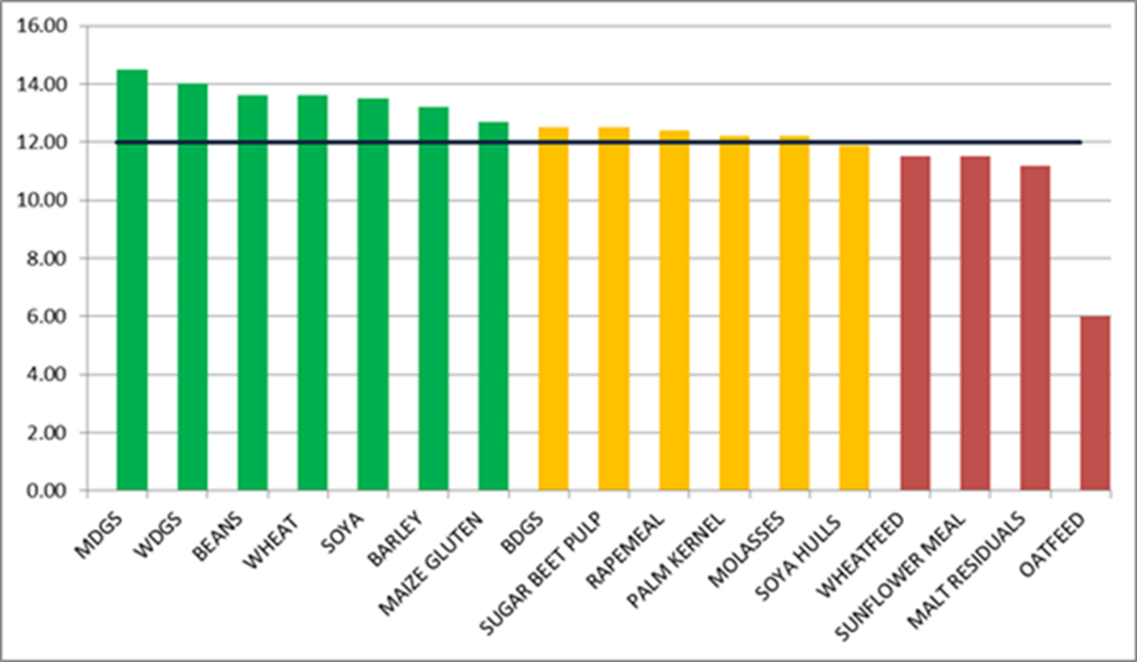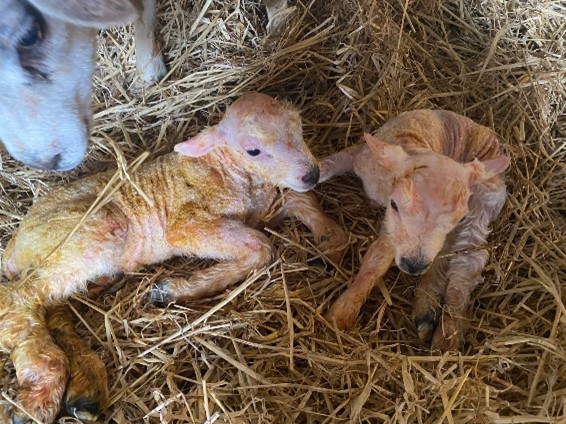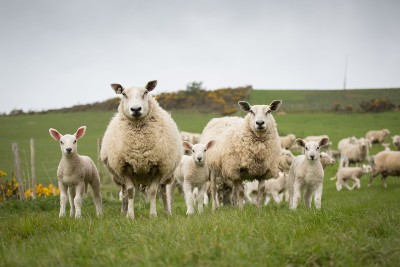Nutrition for Ewes Lambing in Spring
27 March 2024The success of lambing relies heavily upon ensuring the ewe's nutritional needs are met throughout pregnancy. This is particularly important in the final six weeks of pregnancy where foetal growth increases by 70%, in addition to the ewes undergoing udder growth and colostrum production. A high demand for energy and protein is carried on into lactation where the nutrition, condition and health of the ewe directly impact the performance of her lambs.
Are Ewes in the Right Condition?
Condition scoring is the best method to assess the ewe's nutritional status, particularly in the run-up to lambing where the ewe's weight can be heavily affected by pregnancy. Condition scoring is a measurement of the fat cover over the ewes’ transverse processes and short ribs. Keeping a ewe around the target condition and avoiding any large fluctuations in body condition (no more than +/-0.5 condition score) is important to ensure continued performance. A recent study by AHDB found that a +1.0 condition score at lambing can result in an additional 1 kg of total lambs weaned per ewe. For more information refer to TN702 – Condition scoring of mature ewes.

The Importance of Knowing Forage Quality
A forage source such as grass, grass silage or hay will make up the majority of any pre-lambing ewe ration, these forages can be highly variable in quality with a large range between samples in:
- Dry matter.
- Energy.
- Protein
It is important that forage is analysed, before starting to introduce other feeds pre-lambing. This will help decisions on how best to balance the ration, whether this is supplementing with straights in a total mixed ration or with a compound feed, or if these are required at all. For more information on forage analysis see https://www.fas.scot/downloads/ruminant-nutrition-and-forage-analysis/.
Table 1: Target forage quality for pre-lambing ewes:
| Analytical Constituent | Grass | Grass Silage | Hay |
|---|---|---|---|
| Dry Matter | 20% | 25-45% | 80% |
| Metabolisable Energy (MJ/kg DM) | >12.0 | 10.5-12.5 | 9.0 |
| Crude Protein (% DM) | 15-20% | 12.5-16% | 9-10% |
Balancing the Diet to Meet Ewe Requirements
Once forage has been analysed, we need to determine the total nutritional contribution of that forage. Intakes of forage can be highly variable depending on the nutritional quality, preservation characteristics, chop length and how the forage is presented. During pregnancy, a ewe will usually consume between 2.0-2.5% of her body weight in total dry matter, rising to around 2.5 - 3.0% in lactation. Table 2 can be used to predict dry matter intakes depending on forage quality.
Table 2: Guide to predicted daily dry matter intake from forage as a % of body weight for twin-bearing ewes in pregnancy and lactation (AHDB, 2018)
| ME (MJ/kg DM) | 12 to 3 weeks pre-lambing | 3 to 0 weeks pre-lambing | 0-3 weeks into lactation | |
|---|---|---|---|---|
| % of body weight from forage | ||||
| Average hay | 8.5 | 1.5 | 1.1 | 1.2 |
| Good hay | 9.5 | 1.8 | 1.4 | 1.5 |
| Poor silage | 9.5 | 1.4 | 1.2 | 1.3 |
| Good silage | 10.5 | 1.6 | 1.4 | 1.6 |
| Very good silage | 11.5 | 1.8 | 1.7 | 1.8 |
If the nutritional needs of the ewe cannot fully be met with forage alone, the deficit in the diet should be made up of an additional source, such as a compound feed or home mixed straights. For further information on the requirements for energy and protein in late pregnancy and lactation for ewes please refer to Feeding the ewe | AHDB Pages 28-29 and Page 46.
Understanding a Compound Feed Label
Getting the correct compound feed can make all the difference in whether pre-lambing nutrition is successful or not. It can be a difficult task to choose which feed is most suitable for your sheep, forage and system with many compounds available at different prices on the market. Many look the same (a brown nut or roll) and have apparently similar specifications (i.e. high energy and 16-18% crude protein).
The first step to choosing a suitable ewe compound is to obtain a label. A good quality ewe roll/nut should meet the following parameters:
- Oil – 4-5%
- Ash – <10%
- Fibre – <10%
- Crude protein as fed (%) – required percentage will depend on forage quality.
The next step is to look at the ingredient list. Ingredients will always be written in descending order with the most abundant ingredient in the compound first.
Energy is not legally required to be declared but the ingredient list can give a good indication of how much energy the feed will give. Molasses can be a good marker, with an addition of between 3-5% in a compound feed.
The table below gives the energy content of common feed ingredients in the UK. We are aiming for the majority of ingredients to be in the green and yellow categories, and as little of the red category ingredients in the formulation as possible. Given the most abundant ingredients are shown at the start of the label, these should be energy rich.
ME
(MJ/kg DM)

Finally, if buying a complete, mineralised feed it is important that the feed has been mineralised appropriately for pre-lambing ewes. This should include:
- Vitamin A: 8,000-10,000 iu/kg
- Vitamin D3: 2,000 iu/kg
- Vitamin E: 150 iu/kg
- Magnesium: 0.5%
- Selenium 0.5 mg/kg
Identifying Potential Issues before they Arise
Even after silage has been analysed and the ration has been perfectly balanced, there can still be factors that may affect the total intake of the ration and the performance of ewes at lambing. External factors that may affect dry matter intakes of ewes, aside from litter size, weight, body condition or forage and feed quality, include:
- Frequency and timing of feeding. Any concentrate feed above 0.5 kg should be split between two equal feeds at consistent times of day.
- Presentation of feed. Feed should be kept clean and fresh. If feeding ad-lib (and TMR) it is important that it is kept in front of ewes and regularly pushed in.
- Feed access and space. There should be sufficient space for all ewes to feed comfortably. Tables 3 and 4 detail trough space and lying areas.
Table 3: Trough space (AHDB)
| Concentrates (cm/.ewe) | Restricted Forage (cm/ewe) | Ad Lib Forage and TMR (cm/ewe) | |
|---|---|---|---|
| Large ewes (70 - 90kg) | 50 | 25 | 15 |
| Small ewes (50 - 70kg) | 45 | 20 | 15 |
Table 4: Lying area for indoor ewes (AHDB)
| Concentrates (cm/ewe) | |
|---|---|
| In lamb ewe | 1.2 – 1.4 m2/ ewe |
| Early lactation ewe | 1.4 – 1.8 m2/ ewe |
| Lambs to 6 weeks old | 2.0 – 2.2 m2/ ewe |
- Environment – Housed vs outdoors. Remember to factor in increased maintenance requirements in outdoor ewes, due to the impact of weather.
- Shearing ewes pre-housing has shown to increase intakes by up to 15%.
Getting ewe pre-lambing nutrition right can help to avoid problems around lambing e.g. pregnancy toxaemia, dystocia, prolapses, hypocalcaemia, hypomagnesaemia and listeriosis.

Lorna Shaw, SAC Consulting
Related Resources
Sign up to the FAS newsletter
Receive updates on news, events and publications from Scotland’s Farm Advisory Service

